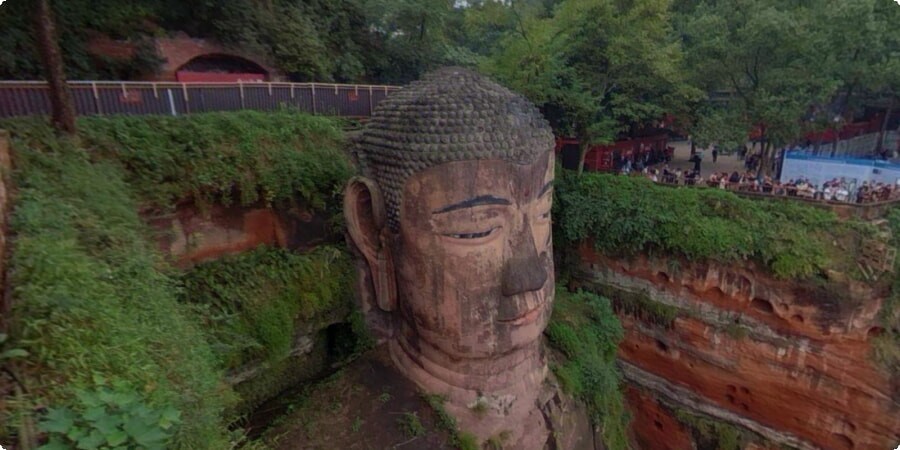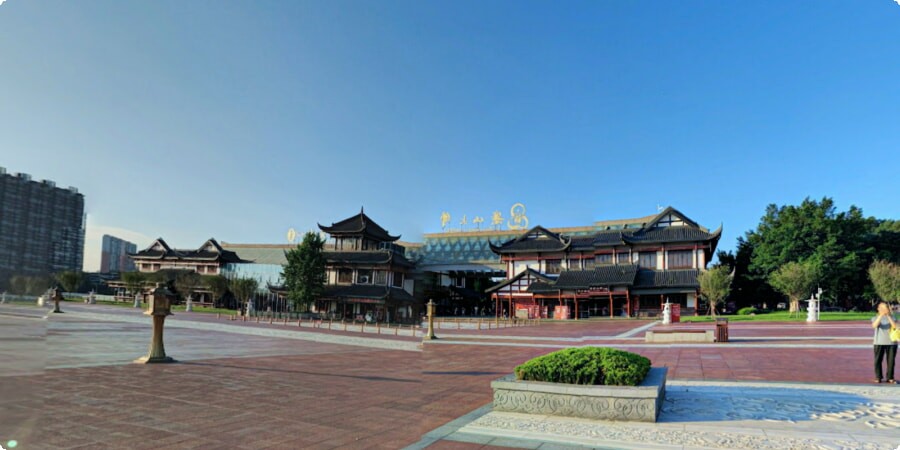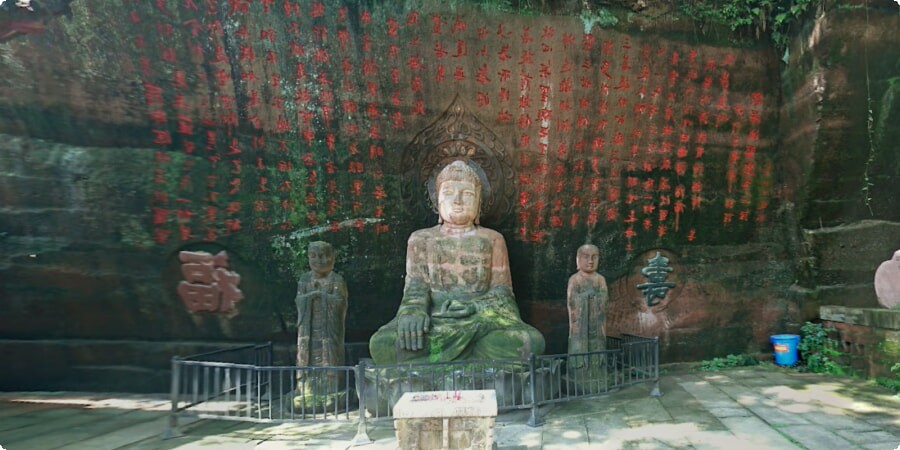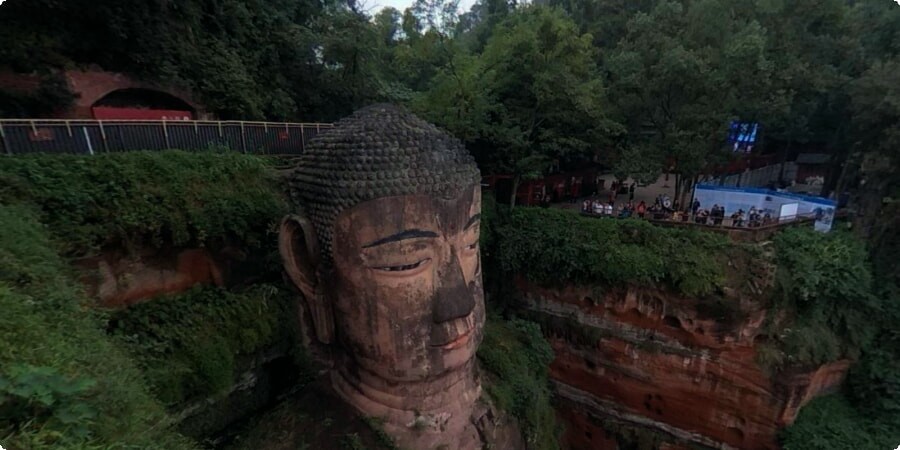The Leshan Giant Buddha: A Traveler's Guide to China's Enormous Statue
Nestled at the confluence of three rivers in Sichuan Province, the Leshan Giant Buddha stands as a breathtaking testament to the grandeur of ancient Chinese art and engineering. Carved into a cliff face overlooking the meeting point of the Minjiang, Dadu, and Qingyi Rivers, this colossal statue of Maitreya—the Buddha of the Future—has captured the imagination of travelers and pilgrims for over a millennium. Standing at an awe-inspiring height of 71 meters (233 feet), it is the largest stone Buddha in the world and one of the most significant ancient Buddhist sculptures.
The Leshan Giant Buddha isn't just a marvel of scale and craftsmanship; it also represents the harmonious blending of natural beauty and human endeavor. The serene expression of the Buddha, gazing down at the river below, seems to invite visitors to reflect on the profound tranquility and timeless wisdom that Buddhism espouses. As one of the UNESCO World Heritage Sites in China, the Leshan Giant Buddha is more than just a historic monument—it's a spiritual journey that connects you with the cultural and philosophical roots of China.
Explore the location on Google Maps
Historical Background: The Story Behind the Statue
The Leshan Giant Buddha was conceived during the Tang Dynasty, a period renowned for its artistic and cultural achievements. The story of the Buddha’s creation is closely tied to the life of a devout Buddhist monk named Haitong. In the early 8th century, Haitong noticed that the turbulent waters at the confluence of the three rivers were causing numerous accidents for passing boats. Believing that a giant statue of the Buddha could help calm the waters, he decided to undertake the monumental task of carving the statue directly into the cliff face.
Haitong's vision was not just about creating a protective deity but also about expressing the Buddhist ideals of compassion and peace. His dedication was so profound that, according to legend, he gouged out his own eyes to demonstrate his sincerity when funding for the project was threatened. Although Haitong did not live to see the completion of the statue, his vision was carried forward by his disciples and later, by the local government. The construction took over 90 years, and upon its completion in 803 AD, the statue not only served as a spiritual guardian but also ingeniously diverted the river currents to reduce the risk of accidents.
The statue is not only a religious icon but also an engineering marvel of its time. Intricate drainage systems were carved into the Buddha’s hair, collar, and chest to prevent erosion and preserve the statue against weathering. This advanced understanding of rock mechanics and hydrology underscores the ingenuity of ancient Chinese craftsmen.
Read more about the Tang Dynasty on Wikipedia

Architectural and Artistic Marvel: Design and Construction
The Leshan Giant Buddha's construction is a testament to the remarkable craftsmanship and sophisticated engineering techniques of the Tang Dynasty. The statue was meticulously carved from a red sandstone cliff, which provides a natural contrast to the lush greenery surrounding it. Standing with his hands resting on his knees, the Buddha exudes a sense of calm and grandeur, his eyes half-closed in a meditative gaze.
One of the most striking features of the Buddha is its size. The head alone is 14.7 meters (48 feet) high, with each ear measuring 7 meters (23 feet) in length—large enough to hold two people standing side by side. The shoulders span 28 meters (92 feet), and each foot is large enough to accommodate more than 100 people. These massive dimensions were not just for show; they were carefully planned to ensure the statue could withstand the natural forces of erosion and seismic activity.
The statue's construction involved an ingenious use of rudimentary tools and techniques. Craftsmen chiseled away at the cliff using simple iron tools, creating a series of niches and grooves to help reduce the weight of the rock and prevent it from collapsing. A complex system of hidden gutters and channels was also designed to drain rainwater away from the statue, minimizing water damage over the centuries. The attention to detail is evident in the Buddha's face, where soft lines and a slight smile give it a lifelike, serene appearance.
For travelers interested in exploring the rich history and architectural wonder of the Leshan Giant Buddha, it's advisable to plan ahead. If you're starting your journey from Shanghai, consider booking a car to fully enjoy the scenic routes and the cultural landmarks along the way. Book a car in Shanghai here to make the most of your travel experience.

Planning Your Visit: When to Go and What to Expect
Visiting the Leshan Giant Buddha is a journey not just through space but also through time, offering a glimpse into the rich spiritual and cultural heritage of China. To make the most of your visit, it’s essential to plan ahead, considering the best times to go and what to expect when you arrive.
Best Time to Visit:
The ideal time to visit the Leshan Giant Buddha is during the spring (March to May) or autumn (September to November). These seasons offer mild weather and clear skies, perfect for exploring the outdoor site without the discomfort of extreme heat or cold. The summer months can be hot and humid, while winter, though less crowded, can be chilly and less visually appealing due to foggy conditions. Early morning visits are recommended to avoid the larger crowds and to witness the Buddha bathed in the soft glow of the rising sun.
Getting There:
Leshan is located about 120 kilometers (75 miles) from Chengdu, the capital of Sichuan Province. The journey from Chengdu to Leshan can be made by bus, train, or car, with the latter offering the most flexibility. If you’re traveling within China, consider booking a car to explore not just the Leshan Giant Buddha but also other nearby attractions at your own pace. Book a car in China here to ensure a smooth and convenient travel experience.
On Arrival:
Upon reaching the site, visitors are greeted by the impressive sight of the Buddha carved into the cliff. The entrance to the park is well-organized, with clearly marked paths leading to various points of interest. Be prepared for some walking, as the path to the Buddha involves a descent along a cliffside staircase that offers spectacular views of the statue and the surrounding landscape. Comfortable shoes and a water bottle are recommended, especially during warmer months.
Exploring the Site: Key Spots and Viewing Points
The Leshan Giant Buddha site is more than just the statue itself—it’s a complex of attractions that offer a deeper understanding of the region’s history and spiritual significance. Here’s a guide to the key spots you shouldn’t miss during your visit:
Lingyun Temple:
Located at the top of the cliff above the Buddha, Lingyun Temple is where your exploration typically begins. The temple, originally built during the Tang Dynasty, was where the construction of the Buddha was initiated. The temple houses several ancient artifacts and statues, and the peaceful atmosphere provides a perfect start to your visit. Don’t forget to explore the temple’s courtyards and gardens, which offer serene spots for reflection and a stunning vantage point over the rivers below.
The Cliffside Path:
Descending the steep cliffside path, known as the Nine Turn Staircase, is an exhilarating experience. As you make your way down, you’ll be treated to breathtaking close-up views of the Buddha from various angles. The staircase is narrow and can get crowded, so take your time and be mindful of your surroundings. The path allows you to appreciate the sheer scale of the statue and the intricate details that are often missed from afar.
Viewing Platforms:
For the best views of the Buddha, make sure to stop at the designated viewing platforms along the way. These platforms are strategically placed to offer different perspectives, from the towering head down to the enormous feet. Each platform provides unique photo opportunities, capturing the Buddha against the backdrop of the river and the surrounding cliffs. The lower platform, near the feet of the Buddha, allows you to fully grasp the colossal size of this ancient marvel.

Local Legends and Myths: Stories Surrounding the Buddha
The Leshan Giant Buddha is steeped in local legends and myths that add a layer of mystique to this already awe-inspiring monument. These stories, passed down through generations, offer a glimpse into the spiritual beliefs and cultural narratives that surround the statue.
The Weeping Buddha:
One of the most famous legends associated with the Leshan Giant Buddha is the tale of the “Weeping Buddha.” According to local lore, in the years following the statue's completion, the surrounding area was plagued by torrential rains and floods, which caused significant damage to the Buddha’s face. The local people believed that the Buddha was weeping because of the suffering of the people and the turbulent waters that continued to threaten their lives. This legend is often cited as a testament to the deep connection between the statue and the natural elements it was meant to tame.
Haitong’s Sacrifice:
Another popular story revolves around the monk Haitong, who is credited with the original idea for the statue. It is said that when funding for the construction was in jeopardy, Haitong gouged out his own eyes to prove his unwavering dedication to the project. This act of self-sacrifice is believed to have inspired the local community and even the regional government to continue supporting the construction. While this tale may be more symbolic than historical, it underscores the intense devotion that went into the creation of the Buddha.
The Power of the Buddha:
Local beliefs hold that the Leshan Giant Buddha has the power to protect the area from natural disasters, particularly floods. For centuries, the statue has been seen as a guardian figure, watching over the confluence of the three rivers. This belief in the Buddha’s protective powers is deeply ingrained in the local culture, and many pilgrims visit the site not only to admire its beauty but also to seek blessings and protection.
These legends and myths contribute to the spiritual significance of the Leshan Giant Buddha, making a visit to the site a journey not just through history and art, but also through the rich tapestry of Chinese folklore.
Exploring the Surroundings: More Attractions Near Leshan
While the Leshan Giant Buddha is undoubtedly the centerpiece of any visit to the region, the surrounding area also boasts a wealth of cultural and natural attractions that are worth exploring. These sites offer a deeper dive into the spiritual and historical tapestry of Sichuan Province.
Wuyou Temple:
Located just a short distance from the Giant Buddha, Wuyou Temple is a hidden gem nestled on the slopes of Mount Wuyou. This temple complex, which dates back to the Tang Dynasty, is renowned for its serene atmosphere, exquisite architecture, and stunning views of the surrounding landscape. The temple is home to a variety of Buddhist artifacts, including ancient sutras and statues, and features beautifully painted halls and pavilions. One of the highlights is the Thousand-Armed Guanyin Hall, where a mesmerizing statue of the bodhisattva of compassion draws visitors into a space of quiet reflection.
Lingbao Pagoda:
Another nearby attraction is the Lingbao Pagoda, a towering structure that stands as a testament to the region’s rich architectural heritage. The pagoda is situated on the top of Lingyun Hill, offering panoramic views of the Leshan cityscape and the Min River below. Climbing to the top of the pagoda provides an excellent opportunity to take in the natural beauty of the area while contemplating the historical significance of this ancient structure.
Mount Emei:
For those with a bit more time, a visit to Mount Emei, one of the Four Sacred Buddhist Mountains of China, is highly recommended. Located about an hour's drive from Leshan, Mount Emei is a UNESCO World Heritage site known for its lush vegetation, diverse wildlife, and numerous temples. Hiking up the mountain offers a spiritual journey through dense forests and along narrow paths lined with ancient stone carvings. At the summit, the Golden Summit Temple offers breathtaking views of the sunrise and the sea of clouds below, providing a serene contrast to the bustling tourist activity around the Giant Buddha.
For a seamless trip around these fascinating sites, it’s advisable to plan your itinerary carefully and consider staying overnight in Leshan or Emeishan. Explore hotel options in China to ensure a comfortable and convenient stay while you explore the wonders of the region.

Tips for a Memorable Visit: What to Know Before You Go
To make the most of your visit to the Leshan Giant Buddha and its surroundings, here are some practical tips and advice to ensure a memorable experience:
Start Early:
The Leshan Giant Buddha is one of China’s most popular tourist attractions, drawing thousands of visitors each day. To avoid the crowds and enjoy a more peaceful experience, aim to arrive early in the morning, just as the park opens. This will not only give you the chance to explore the site at your own pace but also allow you to see the Buddha in the soft morning light, which is ideal for photography.
Dress Comfortably:
Visiting the Leshan Giant Buddha involves a fair amount of walking, including climbing stairs and navigating uneven paths. It’s important to wear comfortable shoes and breathable clothing, especially during the warmer months. Additionally, bringing a hat and sunscreen is advisable, as there is limited shade along the cliffside path.
Stay Hydrated and Snack Smart:
There are a few vendors selling drinks and snacks near the entrance to the site, but options can be limited once you start exploring. Bringing a reusable water bottle and some light snacks can help keep your energy levels up as you navigate the park. Remember to dispose of any waste responsibly to help maintain the site’s natural beauty.
Respect the Culture and Customs:
The Leshan Giant Buddha is not just a tourist attraction; it is a sacred site for Buddhists and a place of great cultural significance. Visitors are encouraged to respect local customs, including dressing modestly and speaking softly within the temple areas. Photography is allowed in most areas, but it’s always a good idea to ask permission if you’re unsure.
Book a Guide for Deeper Insight:
While it’s possible to explore the site independently, hiring a local guide can enhance your experience by providing historical context and sharing stories that you might not find in guidebooks. Guides are available at the entrance, and many speak English or other major languages.
A visit to the Leshan Giant Buddha is more than just a journey to see an enormous statue; it is an exploration of China’s rich cultural and spiritual heritage. Standing in front of this colossal figure, you can't help but feel a sense of awe—not just at the sheer scale of the monument, but at the incredible human effort and devotion that went into creating it. From its serene setting at the confluence of three rivers to the intricate legends that surround it, the Leshan Giant Buddha is a testament to the enduring power of faith, art, and nature.
As you leave the site, take a moment to reflect on the timelessness of this wonder, how it has watched over the river for more than a thousand years, and how it will continue to inspire generations to come. Whether you are a history buff, a spiritual seeker, or simply a traveler looking for an unforgettable experience, the Leshan Giant Buddha offers something profound—a glimpse into the heart of ancient China and the spirit that continues to shape its future.